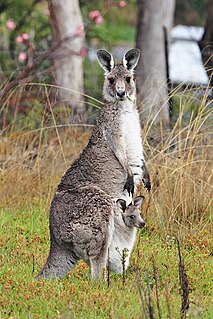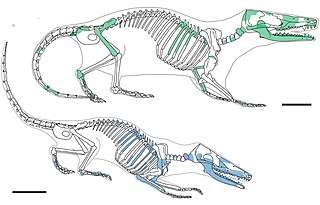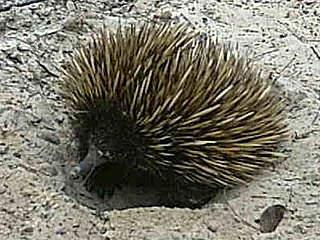
Tribosphenida is a group (infralegion) of mammals that includes the ancestor of Hypomylos, Aegialodontia and Theria. Its current definition is more or less synonymous with Boreosphenida.

Maotherium is a genus extinct symmetrodont mammal that was discovered in Early Cretaceous rocks in Liaoning Province, China, in 2003. Its scientific name directly translates to "fur beast", in reference to the impressions of fur around the fossil. Maotherium belongs to an extinct group of Mesozoic mammals called symmetrodonts. Though little is known about this group, the symmetrodonts have several similarities - specifically their teeth. They have tall pointed, but simple molars in a triangular arrangement. Originally symmetrodonts were known since the 1920s. Now a vast majority have been restored, such as Zhangheotherium and Akidolestes, during the early 21st century. One of the fossils of Maotherium preserved the imprints of fur, like the mammals Eomaia and Sinodelphys.

Symmetrodonta is a group of Mesozoic mammals and mammal-like synapsids characterized by the triangular aspect of the molars when viewed from above, and the absence of a well-developed talonid. The traditional group of 'symmetrodonts' ranges in age from the latest Triassic to the Late Cretaceous, but most research in the last 20-30 years has concluded that they are not a true taxonomic group, but include several unrelated branches of the mammal tree. Despite this, the name is still used informally by some researchers for convenience, usually restricted to the spalacotheriids and zhangheotheriids.

Akidolestes is an extinct genus of mammals from the family spalacotheriid.

Docodonta is an order of extinct mammaliaforms that lived during the Mesozoic, from the Middle Jurassic to Early Cretaceous. They are distinguished from other early mammaliaforms by their relatively complex molar teeth, from which the order gets its name. Until recently, Docodonta were represented primarily by teeth and jaws found across former Laurasia,. However, recent discoveries in China include some exceptionally well preserved, almost complete body fossils.

The Australosphenida are a clade of mammals, containing monotremes and their extinct relatives. Today, there are only five surviving species of monotreme which live in Australia and New Guinea. Fossils of australosphenidans have been found from the Jurassic of Madagascar and Argentina, as well as the Cretaceous of Australia. The surviving species consist of the platypus and four species of echidna. Contrary to other known crown mammals, they retained postdentary bones as shown by the presence of a postdentary trough. The extant members (monotremes) developed the mammalian middle ear independently.

The evolution of mammals has passed through many stages since the first appearance of their synapsid ancestors in the Pennsylvanian sub-period of the late Carboniferous period. By the mid-Triassic, there were many synapsid species that looked like mammals. The lineage leading to today's mammals split up in the Jurassic; synapsids from this period include Dryolestes, more closely related to extant placentals and marsupials than to monotremes, as well as Ambondro, more closely related to monotremes. Later on, the eutherian and metatherian lineages separated; the metatherians are the animals more closely related to the marsupials, while the eutherians are those more closely related to the placentals. Since Juramaia, the earliest known eutherian, lived 160 million years ago in the Jurassic, this divergence must have occurred in the same period.

Yanoconodon is a monotypic genus of extinct early mammal whose representative species Yanoconodon allini lived during the Mesozoic in what is now China. The holotype fossil of Yanoconodon was excavated in the Yan Mountains about 300 kilometres from Beijing in the Qiaotou member of the Huajiying Formation of Hebei Province, China, and is therefore of uncertain age. The Qiaotou Member may correlate with the more well-known Early Cretaceous Yixian Formation, and so probably dates to around 122 Ma ago.
Diarthrognathus is an extinct genus of tritheledontid cynodonts, known from fossil evidence found in South Africa and first described in 1958 by A.W. Crompton. The creature lived during the Early Jurassic period, about 200 million years ago. It was carnivorous and small, slightly smaller than Thrinaxodon, which was under 50 centimetres (20 in) long.

The evolution of mammalian auditory ossicles was an evolutionary event that resulted in the formation of the bones of the mammalian middle ear. These bones, or ossicles, are a defining characteristic of all mammals. The event is well-documented and important as a demonstration of transitional forms and exaptation, the re-purposing of existing structures during evolution.

Dryolestida is an extinct order of mammals; most of the members are mostly known from the Jurassic to Paleogene, with one member, Necrolestes, surviving as late as the early Miocene. They are considered members of the clade Cladotheria, close to the ancestry of therian mammals. It is also believed that they developed a fully mammalian jaw and also had the three middle ear bones. Other than that, not much is known about them, because their fossils are made up mostly of jaw and tooth remains.

Morganucodonta is an extinct order of basal Mammaliaformes, a group including crown-group mammals (Mammalia) and their close relatives. Their remains have been found in Southern Africa, Western Europe, North America, India and China. The morganucodontans were probably insectivorous and nocturnal, though like eutriconodonts some species attained large sizes and were carnivorous. Nocturnality is believed to have evolved in the earliest mammals in the Triassic as a specialisation that allowed them to exploit a safer, night-time niche, while most larger predators were likely to have been active during the day.
Shuotherium is a fossil mammal known from Middle-Late Jurassic of the Forest Marble Formation of England, and the Shaximiao Formation of Sichuan, China.

Kuehneotherium is an early mammaliaform genus, previously considered a holothere, that lived during the Late Triassic-Early Jurassic Epochs and is characterized by reversed-triangle pattern of molar cusps. Although many fossils have been found, the fossils are limited to teeth, dental fragments, and mandible fragments. The genus includes Kuehneotherium praecursoris and all related species. It was first named and described by Doris M. Kermack, K. A. Kermack, and Frances Mussett in November 1967. The family Kuehneotheriidae and the genus Kuehneotherium were created to house the single species Kuehneotherium praecursoris. Modeling based upon a comparison of the Kuehneotherium jaw with other mammaliaforms indicates it was about the size of a modern-day shrew between 4 and 5.5 g at adulthood.

Monotremes are prototherian mammals of the order Monotremata. They are one of the three main groups of living mammals, along with placentals (Eutheria) and marsupials (Metatheria). Monotremes are typified by structural differences in their brains, jaws, digestive tract, reproductive tract, and other body parts compared to the more common mammalian types. In addition, they lay eggs rather than bearing live young, but, like all mammals, the female monotremes nurse their young with milk.

Gobiconodonta is an order of extinct mammals known from the Early Jurassic to early Late Cretaceous. They are generally held to be part of Eutriconodonta.
Megaconus is an extinct genus of mammaliaforms from the Middle Jurassic Tiaojishan Formation of Inner Mongolia, China. The type and only species, Megaconus mammaliaformis, was first described in the journal Nature in 2013. Megaconus is thought to have been a herbivore that lived on the ground, having a similar posture to modern-day armadillos and rock hyraxes. Megaconus is a member of a group called Haramiyida. A phylogenetic analysis published along with its first description showed that haramiyidans originated before the appearance of true mammals, but an accompanying description of the haramiyidan Arboroharamiya in the same issue of Nature indicated that haramyidans were true mammals. If haramiyidans are not mammals, Megaconus would be one of the most basal ("primitive") mammaliaforms to possess fur, and an indicator that fur evolved in the ancestors of mammals and not the mammals themselves.

Yinotheria is a proposed basal subclass clade of crown mammals uniting the Shuotheriidae, an extinct group of mammals from the Jurassic of Eurasia, with Australosphenida, a group of mammals known from the Jurassic to present of Gondwana, including living monotremes. Today, there are only five surviving species of monotremes which live in Australia and New Guinea, consisting of the platypus and four species of echidna. Fossils of yinotheres have been found in England, China, Russia, Madagascar and Argentina. Contrary to other known crown mammals, they retained postdentary bones as shown by the presence of a postdentary trough. The extant members (monotremes) developed the mammalian middle ear independently.
Wareolestes rex is a mammaliaform from the Middle Jurassic (Bathonian) rocks of England and Scotland. It was originally known from isolated teeth from England, before a more complete jaw with teeth was found in the Kilmaluag Formation of Skye, Scotland.

Vilevolodon is an extinct, monotypic genus of volant, arboreal euharamiyids from the Oxfordian age of the Late Jurassic of China. The type species is Vilevolodon diplomylos. The genus name Vilevolodon references its gliding capabilities, Vilevol, while don is a common suffix for mammalian taxon titles. The species name diplomylos refers to the dual mortar-and-pestle occlusion of upper and lower molars observed in the holotype; diplo, mylos.














